"Tariff Tantrum" Triggers The Retest Phase
The "Tariff Tantrum," as it is being called, is clearly the current focal point of the market. With the glaring exception of the White House, most everyone agrees that embarking on a trade war doesn't do anybody much good. And whether or not the President actually makes good on the threat to impose tariffs of 25% on steel and 10% on aluminium remains to be seen.
However, the bottom line here is markets hate uncertainty and the proposed tariffs bring all kinds of uncertainty into the mix. Profits. Retaliation. And unintended circumstances to the economy are the primary issues traders appear to be fretting over presently.
Just like that, the two-week rally off the correction low ended and the "retest" began. Anyone who has been around awhile knows that emotional declines tend to follow a similar pattern. Something I call the "crash playbook." First, there is the dive that comes out of nowhere. Then the emotional or panic low. Then the "dead cat bounce." Then the "retest." And finally, the "bottoming/basing phase" takes hold. And the entire process tends to take a few months.
So, with the S&P 500 putting in three pretty strong down days and breaking back below its 50-day moving average last week, it appears that the "retest" is underway. The question now, of course, is how low will it go?
Remember, a retest can take many forms. The market can simply head down for a few days before buyers decide values are good and it's time to get back in the game. Or the retest can become much more literal and stocks run back down to the prior lows - sometimes even exceeding those panic lows. Such a move tends to be scary and wash out the remaining "weak hands." This creates a moment where everybody who wants/needs to sell, does so. And in short, this is the stuff that bottoms are made of.
What Do The Indicators Say?
Whenever the question of what Ms. Market is likely to do next from an intermediate-term perspective arises, I look to my indicators for clues. And this is what my Monday morning report is all about.
In looking at the indicator boards, it is clear that the Trend indicators are not so hot right now. The Momentum indicators vary by time-frame. The Early Warning board is starting to lean bullish. And the External Factors board is a bit discouraging. However, my "Primary Cycle" board, which is a group of my favorite longer-term market models designed to tell me which team is in charge, suggests that this remains a bull market until proven otherwise.
Sure, the Risk/Reward Model is negative. But as I've been saying for over a year, this model has been struggling with the current environment due to the heavy emphasis on monetary and sentiment indicators in the model. Yet at the same time, the fact that the model reading is red, should remind us that this is NOT a low risk environment.
My Take
My takeaway on this windy Monday morning in Golden, Colorado is that we have a "bad news" market on our hands at the present time. This trend is occurring within a corrective phase, which is occurring within a cyclical bull market, which is occurring within the context of a secular bull phase. So, while there is no telling what stocks will do this week, I believe we remain in a buy-the-dips environment.
With that said however, we must keep in mind, that all good things come to an end at some point. Therefore, it is important to remain alert for things like a peak in either earnings or economic growth and to stay flexible.
Thought For The Day:
Don't worry about losing. Think about winning. – Mike Krzyzewski
Wishing you green screens and all the best for a great day,

David D. Moenning
Founder, Chief Investment Officer
Heritage Capital Research
HCR Focuses on a Risk-Managed Approach to Investing
Must Read: What Risk Management Can and Cannot Do
HCR's Financial Advisor Services
HCR's Individual Investor Services
Questions, comments, or ideas? Contact Us
At the time of publication, Mr. Moenning held long positions in the following securities mentioned: None - Note that positions may change at any time.
The State of the Big-Picture Market Models
It's a new week, so let's start things off with a review of the state of my favorite big-picture market models, which are designed to tell us which team is in control of the prevailing major trend.

View My Favorite Market Models Online
Executive Summary:
- The Leading Indicators model, which is long-term oriented, remains on a long-term buy signal, but the indicator level remains neutral for the second straight week.
- We have recently upgraded our "State of the tape" model to include an additional 5 indicator readings. The current reading of the new model is positive and suggests the dips should be bought.
- The Risk/Reward model remains negative and on sell signal. As I've been saying, I think this model has too much emphasis on monetary conditions and sentiment. But, the sell signal remains notable as the model has a solid long-term record. Remember that one of the primary reasons we utilize multiple models in our work is that all models/indicators flash false signals from time to time and/or "get out of whack" with the environment.
- My "desert island" model, which is a combination of trend, momentum, and external factors, remains on a long-term buy signal.
- The newly expanded External Factors model remains positive to start the week. As I've been saying, this suggests that the cyclical bull trend remains intact.
- The bottom line is that while traders are focused on the potential for a trade war and the major indices appear to be in "retest mode," this board suggests the bulls are likely to prevail and that the dips should continue to be bought.
The State of the Trend
Digging into the details, I like to start my weekly review with a look at the "state of the trend." These indicators are designed to give us a feel for the overall health of the current short- and intermediate-term trend models.
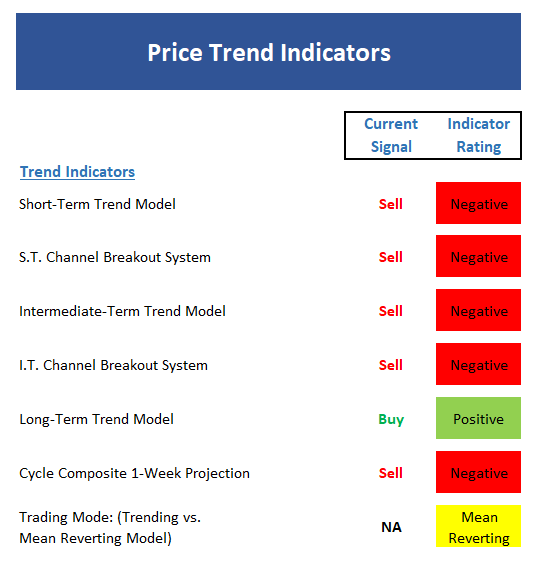
View Trend Indicator Board Online
Executive Summary:
- The "Tarrif Tantrum" caused the short-term Trend Model to flip to negative. And with our shorter-term mas all moving lower, it is going to take a sustained rebound in order for the model to turn green.
- Our short-term Channel Breakout system remains negative to start the week. However, with stocks in a mean-reverting mode, a move above 2700 Monday would produce a buy signal.
- The intermediate-term Trend Model is now negative and requires a weekly close above 2745 to reverse.
- The intermediate-term Channel Breakout System remains on its 2/5 sell signal. A close above 2839 would produce a new buy signal.
- The long-term Trend Model remains positive. As I've been saying, this is a reminder that we are experiencing a correction at this time - and not a bear market.
- The Cycle Composite points lower this week, albeit only modestly so. The cycles suggest a very choppy uptrend into late-March.
- From an intermediate-term perspective, the market remains in a mean-reverting mode.
- In sum, the trend weakened last week as the major indices appear to be in "retest" mode. Thus, the question is, will the test succeed or fail?
The State of Internal Momentum
Next up are the momentum indicators, which are designed to tell us whether there is any "oomph" behind the current trend.
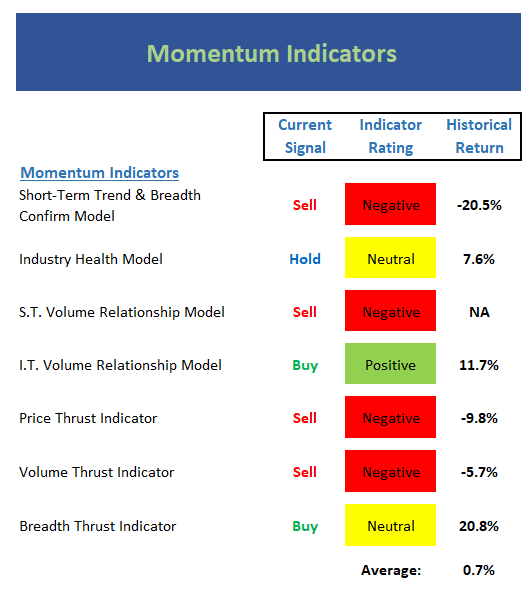
View Momentum Indicator Board Online
Executive Summary:
- The short-term Trend and Breadth Confirm Model turned negative this week. However, this model appears to be in a flip-flop mode at the present time.
- The Industry Health Model remains in the neutral zone. However, as I've been saying, it is important to note that this model has NOT flashed a sell signal. This tells us that longer-term investors should continue to side with the bulls.
- The short-term Volume Relationship model flipped back to negative last week and our measure of down volume has reached the highest level seen since the mini bear market that ended in Feb 2016. This suggests that the current corrective phase could stick around a while.
- The intermediate-term Volume Relationship Model remains positive and is another indication that this remains a bull market until proven otherwise.
- The intermediate-term Price Thrust Indicator did a nice job of warning that the bulls were not out of the woods recently. The model remains modestly negative to start the week.
- The good news is the Volume Thrust Indicator improved to positive last week. The bad news is the indicator has yet to flash a fresh buy signal.
- The Breadth Thrust Indicator weakened last week but remains on the 2/23 buy signal
- Market momentum took a hit last week. And since we have not seen a series of breadth thrust signals, this argues that the corrective phase remains intact.
The State of the "Trade"
We also focus each week on the "early warning" board, which is designed to indicate when traders might start to "go the other way" -- for a trade.
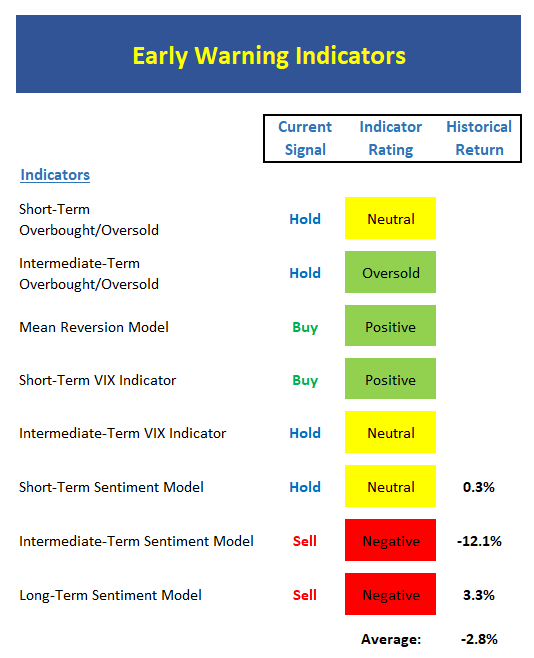
View Early Warning Indicator Board Online
Executive Summary:
- From a near-term perspective, stocks are coming off an overbought condition and are now neutral.
- From an intermediate-term view, stocks are once again oversold - although only modestly so. We would prefer to see both indicators lined up here.
- The Mean Reversion Model remains on its 2/14 buy signal.
- The short-term VIX indicator gave a timely sell signal on 2/27 but switched to a buy signal on Friday.
- With VIX levels remaining elevated, our intermediate-term VIX signal is currently "adjusting" to the new environment.
- From a short-term perspective, market sentiment recently reached the extreme pessimism zone and has now reversed to neutral.
- The intermediate-term Sentiment Model remains in the red zone to start the week.
- The Long-Term Sentiment Model reading is currently at the upper end of negative. However, it is worth noting that the extreme optimism reading has been largely worked off.
The State of the Macro Picture
Now let's move on to the market's "external factors" - the indicators designed to tell us the state of the big-picture market drivers including monetary conditions, the economy, inflation, and valuations.
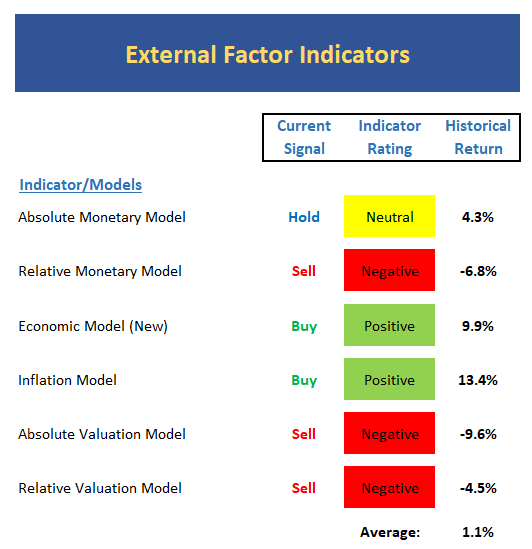
View External Factors Indicator Board Online
Executive Summary:
- The Absolute Monetary model remains very close to a sell signal. As I wrote last week, I feel this is a good summary of the monetary environment. The bond market is either due for a big bounce or embarking on a new bear. This remains an important input to the stock market narrative.
- The Relative Monetary Model continues to move lower in negative territory and on a sell signal.
- The Economic Model continues to suggest a strong economic environment and decent equity returns.
- The Inflation Model remains positive and is a long way from suggesting high inflationary pressure. This is a positive for holders of bonds and a negative for the bond bears. However, bond traders are uber-sensitive to any indication that the scales are about to be tipped.
- The Absolute Valuation Model is negative and the reading is at the worst levels since the crisis ended.
- Our Relative Valuation Model (which incorporates the current level of interest rates) remains on the sell signal flashed at the beginning of the month. I continue to see this as a warning flag.
- The message from the External Factors board is that risk factors remain elevated.
Sample Tactical Allocation Model
Below is an EXAMPLE (and ONLY an EXAMPLE) of how one might incorporate the indicator boards. The approach shown below is designed to provide the current equity allocation for a balanced tactical asset allocation model with a base target of 60/40 stocks/bonds.
The overall intent of the model is to keep equity exposure in line with current conditions.
Beginning February 2018, the model will be updated monthly.
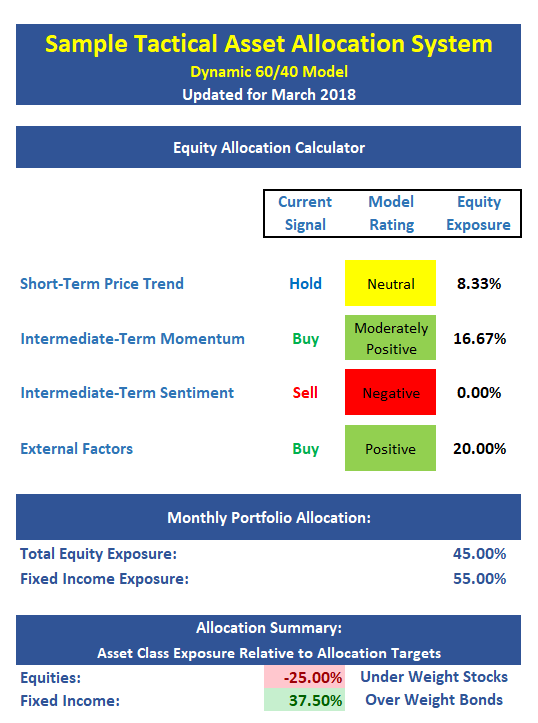
The model above is for illustrative and informational purposes only and does not in any way represent any investment recommendation. The model is merely a sample of how indicators can be grouped to create a guide to market exposure based on the inputs from multiple indicators/models.
Indicators Explained
Short-Term Trend-and-Breadth Signal Explained: History shows the most reliable market moves tend to occur when the breadth indices are in gear with the major market averages. When the breadth measures diverge, investors should take note that a trend reversal may be at hand. This indicator incorporates NDR's All-Cap Dollar Weighted Equity Series and A/D Line. From 1998, when the A/D line is above its 5-day smoothing and the All-Cap Equal Weighted Equity Series is above its 25-day smoothing, the equity index has gained at a rate of +32.5% per year. When one of the indicators is above its smoothing, the equity index has gained at a rate of +13.3% per year. And when both are below, the equity index has lost +23.6% per year.
Channel Breakout System Explained: The short-term and intermediate-term Channel Breakout Systems are modified versions of the Donchian Channel indicator. According to Wikipedia, "The Donchian channel is an indicator used in market trading developed by Richard Donchian. It is formed by taking the highest high and the lowest low of the last n periods. The area between the high and the low is the channel for the period chosen."
Intermediate-Term Trend-and-Breadth Signal Explained: This indicator incorporates NDR's All-Cap Dollar Weighted Equity Series and A/D Line. From 1998, when the A/D line is above its 45-day smoothing and the All-Cap Equal Weighted Equity Series is above its 45-day smoothing, the equity index has gained at a rate of +17.6% per year. When one of the indicators is above its smoothing, the equity index has gained at a rate of +6.5% per year. And when both are below, the equity index has lost -1.3% per year.
Industry Health Model Explained: Designed to provide a reading on the technical health of the overall market, Big Mo Tape takes the technical temperature of more than 100 industry sectors each week. Looking back to early 1980, when the model is rated as "positive," the S&P has averaged returns in excess of 23% per year. When the model carries a "neutral" reading, the S&P has returned over 11% per year. But when the model is rated "negative," stocks fall by more than -13% a year on average.
Cycle Composite Projections: The cycle composite combines the 1-year Seasonal, 4-year Presidential, and 10-year Decennial cycles. The indicator reading shown uses the cycle projection for the upcoming week.
Trading Mode Indicator: This indicator attempts to identify whether the current trading environment is "trending" or "mean reverting." The indicator takes the composite reading of the Efficiency Ratio, the Average Correlation Coefficient, and Trend Strength models.
Volume Relationship Models: These models review the relationship between "supply" and "demand" volume over the short- and intermediate-term time frames.
Price Thrust Model Explained: This indicator measures the 3-day rate of change of the Value Line Composite relative to the standard deviation of the 30-day average. When the Value Line's 3-day rate of change have moved above 0.5 standard deviation of the 30-day average ROC, a "thrust" occurs and since 2000, the Value Line Composite has gained ground at a rate of +20.6% per year. When the indicator is below 0.5 standard deviation of the 30-day, the Value Line has lost ground at a rate of -10.0% per year. And when neutral, the Value Line has gained at a rate of +5.9% per year.
Volume Thrust Model Explained: This indicator uses NASDAQ volume data to indicate bullish and bearish conditions for the NASDAQ Composite Index. The indicator plots the ratio of the 10-day total of NASDAQ daily advancing volume (i.e., the total volume traded in stocks which rose in price each day) to the 10-day total of daily declining volume (volume traded in stocks which fell each day). This ratio indicates when advancing stocks are attracting the majority of the volume (readings above 1.0) and when declining stocks are seeing the heaviest trading (readings below 1.0). This indicator thus supports the case that a rising market supported by heavier volume in the advancing issues tends to be the most bullish condition, while a declining market with downside volume dominating confirms bearish conditions. When in a positive mode, the NASDAQ Composite has gained at a rate of +38.3% per year, When neutral, the NASDAQ has gained at a rate of +13.3% per year. And when negative, the NASDAQ has lost at a rate of -8.5% per year.
Breadth Thrust Model Explained: This indicator uses the number of NASDAQ-listed stocks advancing and declining to indicate bullish or bearish breadth conditions for the NASDAQ Composite. The indicator plots the ratio of the 10-day total of the number of stocks rising on the NASDAQ each day to the 10-day total of the number of stocks declining each day. Using 10-day totals smooths the random daily fluctuations and gives indications on an intermediate-term basis. As expected, the NASDAQ Composite performs much better when the 10-day A/D ratio is high (strong breadth) and worse when the indicator is in its lower mode (weak breadth). The most bullish conditions for the NASDAQ when the 10-day A/D indicator is not only high, but has recently posted an extreme high reading and thus indicated a thrust of upside momentum. Bearish conditions are confirmed when the indicator is low and has recently signaled a downside breadth thrust. In positive mode, the NASDAQ has gained at a rate of +22.1% per year since 1981. In a neutral mode, the NASDAQ has gained at a rate of +14.5% per year. And when in a negative mode, the NASDAQ has lost at a rate of -6.4% per year.
Short-Term Overbought/sold Indicator: This indicator is the current reading of the 14,1,3 stochastic oscillator. When the oscillator is above 80 and the %K is above the %D, the indicator gives an overbought reading. Conversely, when the oscillator is below 20 and %K is below its %D, the indicator is oversold.
Intermediate-Term Overbought/sold Indicator: This indicator is a 40-day RSI reading. When above 57.5, the indicator is considered overbought and when below 45 it is oversold.
Mean Reversion Model: This is a diffusion model consisting of five indicators that can produce buy and sell signals based on overbought/sold conditions.
VIX Indicator: This indicator looks at the current reading of the VIX relative to standard deviation bands. When the indicator reaches an extreme reading in either direction, it is an indication that a market trend could reverse in the near-term.
Short-Term Sentiment Indicator: This is a model-of-models composed of 18 independent sentiment indicators designed to indicate when market sentiment has reached an extreme from a short-term perspective. Historical analysis indicates that the stock market's best gains come after an environment has become extremely negative from a sentiment standpoint. Conversely, when sentiment becomes extremely positive, market returns have been subpar.
Intermediate-Term Sentiment Indicator: This is a model-of-models composed of 7 independent sentiment indicators designed to indicate when market sentiment has reached an extreme from an intermediate-term perspective. Historical analysis indicates that the stock market's best gains come after an environment has become extremely negative from a sentiment standpoint. Conversely, when sentiment becomes extremely positive, market returns have been subpar.
Long-Term Sentiment Indicator: This is a model-of-models composed of 6 independent sentiment indicators designed to indicate when market sentiment has reached an extreme from a long-term perspective. Historical analysis indicates that the stock market's best gains come after an environment has become extremely negative from a sentiment standpoint. Conversely, when sentiment becomes extremely positive, market returns have been subpar.
Absolute Monetary Model Explained: The popular cliché, "Don't fight the Fed" is really a testament to the profound impact that interest rates and Fed policy have on the market. It is a proven fact that monetary conditions are one of the most powerful influences on the direction of stock prices. The Absolute Monetary Model looks at the current level of interest rates relative to historical levels and Fed policy.
Relative Monetary Model Explained: The "relative" monetary model looks at monetary indicators relative to recent levels as well as rates of change and Fed Policy.
Economic Model Explained: During the middle of bull and bear markets, understanding the overall health of the economy and how it impacts the stock market is one of the few truly logical aspects of the stock market. When our Economic model sports a "positive" reading, history (beginning in 1965) shows that stocks enjoy returns in excess of 21% per year. Yet, when the model's reading falls into the "negative" zone, the S&P has lost nearly -25% per year. However, it is vital to understand that there are times when good economic news is actually bad for stocks and vice versa. Thus, the Economic model can help investors stay in tune with where we are in the overall economic cycle.
Inflation Model Explained: They say that "the tape tells all." However, one of the best "big picture" indicators of what the market is expected to do next is inflation. Simply put, since 1962, when the model indicates that inflationary pressures are strong, stocks have lost ground. Yet, when inflationary pressures are low, the S&P 500 has gained ground at a rate in excess of 13%. The bottom line is inflation is one of the primary drivers of stock market returns.
Valuation Model Explained: If you want to get analysts really riled up, you need only to begin a discussion of market valuation. While the question of whether stocks are overvalued or undervalued appears to be a simple one, the subject is extremely complex. To simplify the subject dramatically, investors must first determine if they should focus on relative valuation (which include the current level of interest rates) or absolute valuation measures (the more traditional readings of Price/Earnings, Price/Dividend, and Price/Book Value). We believe that it is important to recognize that environments change. And as such, the market's focus and corresponding view of valuations are likely to change as well. Thus, we depend on our Valuation Models to help us keep our eye on the ball.
Disclosures
The opinions and forecasts expressed herein are those of Mr. David Moenning and may not actually come to pass. Mr. Moenning's opinions and viewpoints regarding the future of the markets should not be construed as recommendations. The analysis and information in this report is for informational purposes only. No part of the material presented in this report is intended as an investment recommendation or investment advice. Neither the information nor any opinion expressed constitutes a solicitation to purchase or sell securities or any investment program.
Any investment decisions must in all cases be made by the reader or by his or her investment adviser. Do NOT ever purchase any security without doing sufficient research. There is no guarantee that the investment objectives outlined will actually come to pass. All opinions expressed herein are subject to change without notice. Neither the editor, employees, nor any of their affiliates shall have any liability for any loss sustained by anyone who has relied on the information provided.
Mr. Moenning may at times have positions in the securities referred to and may make purchases or sales of these securities while publications are in circulation. Positions may change at any time.
The analysis provided is based on both technical and fundamental research and is provided "as is" without warranty of any kind, either expressed or implied. Although the information contained is derived from sources which are believed to be reliable, they cannot be guaranteed.
Investments in equities carry an inherent element of risk including the potential for significant loss of principal. Past performance is not an indication of future results.
